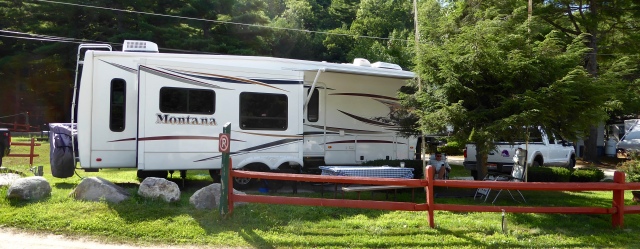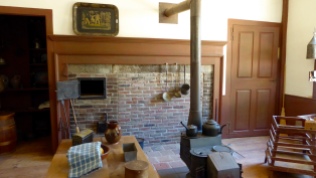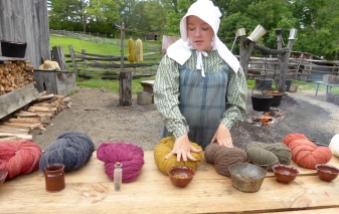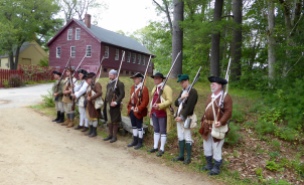Sturbridge is 60 miles southwest of Boston, Massachusetts. We visited Boston years ago, loved the city, and would be delighted to visit again someday. Yet, for this visit to Massachusetts, our focus was Sturbridge.
We stayed in Sturbridge Campground, in the town of Sturbridge, for the purpose of visiting Old Sturbridge Village. A lot of Sturbridge going on….

We lucked into the nicest campsite available in one of our least favorite campgrounds ever. If we hadn’t been given this nice site, in contrast to the normal awful ones, we wouldn’t have spent six nights here! As it was we shortened our stay from 10 nights to six…

How the other campers lived…..
 We did enjoy a multitude of hummingbird visitors while hanging out in our shaded yard feeling bad for everyone else.
We did enjoy a multitude of hummingbird visitors while hanging out in our shaded yard feeling bad for everyone else.
We didn’t spend much time in the town of Sturbridge but we did go see Star Trek Beyond and Jason Bourne. It had been a while since we had the time and opportunity to see a movie in a theater.

Old Sturbridge Village was the reason for visiting the area and it was terrific!

As you walk through the village, and surrounding farms, you are able to talk with costumed historians and learn about “their” life. Most sites had a historian available for our mid-week summer visit.
The firearms cabin held a large variety of rifles, hand guns, shot and powder horns. The top rifle is a flintlock fowler from 1725 New England. It was six or seven feet long. Who could carry and shoot that thing?

We learned about flintlock rifles and how they are fired. This demonstrator could reload and fire three times in a minute. (We learned that a crew from Jeopardy filmed this and other demonstrations as “answers” for the show. We saw them several times throughout the afternoon. Those who watch Jeopardy, like my parents, will see Sturbridge references sometime soon.)
There was also a childrens group at Sturbridge for a day camp. They seemed to be having a great time.
We toured a village town home and saw how it was decorated.

We watched oxen pull a wagon and stayed to see them unburdened from their 50 pound yoke. No one but me thought 50 pounds was needlessly heavy for the poor oxen.
We spoke with this farmer as he was using a scythe to cut grass for the cattle. With steady cutting, a blade needed quick sharpening in the field every 15 minutes. It would need to be sharpened more thoroughly after a full days work. A man would cut an acre a day alone although usually a group of men worked together to cut fields more efficiently.
We saw wool from the sheep processed in the carding machine….
…to the spinning wheel to the dye pot.
Bright wall paper, produced in New England, decorated the early homes. Space was well utilized with an early “murphy” bed.

We went to a farm and learned about the crops and medicinal plants grown there. Some plants were brought from Europe and others were acquired from Native Americans.

There were flies everywhere in this village kitchen so there was no temptation to snack! In 1830s New England, people didn’t know there was a reason to worry about flies on food and no practical way to keep them away.

The village had a cooper shop to make needed containers.
The village potter makes the vessels that were used in 1838. Once a year he fires 600-700 pots in the old kiln. Others are fired using modern methods.
The school teacher was 16 years old and made $6-8 per month, half of what a male teacher would make. Gender inequality started early… She taught the alphabet to her youngest children but older pupils, up to 50 total, would study independently and come to her to recite their lessons.

The cobbler demonstrated making leather shoes. In early New England most common shoes did not have a differentiated left and right.
An experienced tin maker could make 16 of these lanterns in one work day.

By 1838, most tools were made in a New England factory and the blacksmith was a repairman.

The shopkeeper sold goods from all over the world. Villagers made butter and cheese as credit to buy what goods they needed and could not make. The shopkeeper took the butter and cheese to the city to trade for goods. These days, items made in the village such as pots, brooms, yarn and tin goods are available in the museum gift shop

This was the pound for stray farm animals. The animal would be caught, impounded, and the owner would pay a fee to get it back.
Please don’t think we’ve shown you so much of Old Sturbridge Village that visiting is unnecessary. It is absolutely necessary! We had a great time and took advantage of a second visit free within 10 days.
Why go again? Because New England’s largest Revolutionary War Re-enactment was held while we were here.

A commander of a militia unit was able to take some of the comforts from home. His qualification for being the commander was that he was the wealthiest citizen, even though he may have had no military training.

The British wore tall hats and cutaway jackets to appear bigger and taller and thus, more intimidating to foes.

We weren’t sure which side these guys were on! See the fox? We did’t get a chance to ask what that was all about.
The cavalry riders came through the infantry line after the guns were fired. Only two revolutionary war battles used cavalry.

The guns were fired in a volley because they were more likely to hit something that way. Individual shots were not very accurate or reliable.

And with all the re-enacted shooting going on, the next stop was the doctor at the regimental “flying hospital”, a precursor to MASH units. A doctor became a doctor by purchasing a manual, no experience or training required. Midwifes often treated maladies that didn’t require “cutting” and used herbs for treatment. Of course, there was no knowledge of bacteria or how to treat infection.
The re-enactors came to Old Sturbridge Village on Friday evening and stayed for the weekend – quite the dedication to this event. We are glad we had a chance to enjoy the fun.
Old Sturbridge Village was developed because Albert Wells loved to collect everyday items from early New England. His collection was the beginning seed for the living history museum which opened in 1946.

These are two of about 20 early mouse traps displayed. At least they knew they didn’t want mice – even if they didn’t know they didn’t want flies!

Collecting was a family trait. Brother J. Cheney Wells collected clocks and over 110 are displayed in the adjacent gallery.

These clocks were from the mid 1700s. Most displays included one showing the inner workings.

Ever the engineer, Randy was disappointed this clock wasn’t working and spent time figuring out how it would work.
Next stop….Connecticut!

































Did you feel the urge to grab a scythe and start cutting hay?? Looks like a lot of history in one place!
The scythe was super sharp! He moved through the grass very easily.
Tons of interesting history at the village but today was way too muggy to stay long at the reenactment. Felt bad for the people dressed in all those layers!